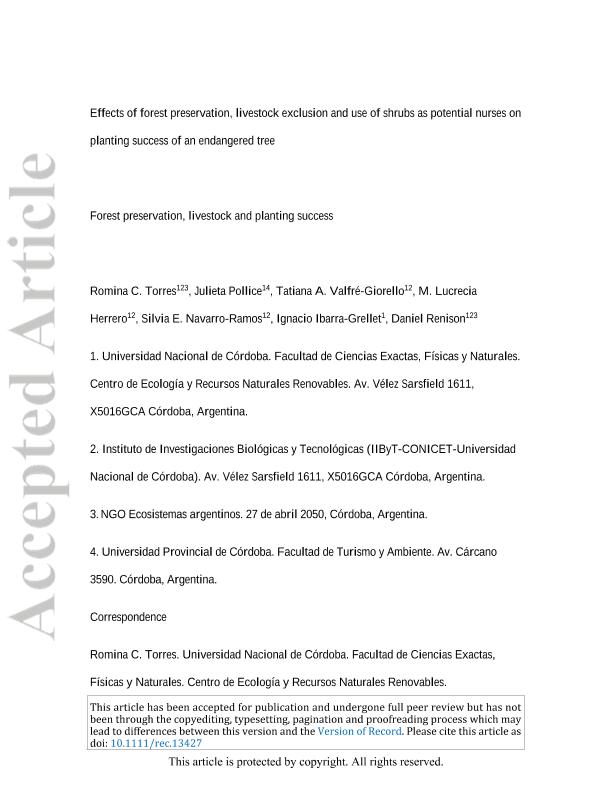Artículo
Effects of forest preservation, livestock exclusion and use of shrubs as potential nurses on planting success of an endangered tree
Torres, Romina Cecilia ; Pollice, Julieta
; Pollice, Julieta ; Valfré Giorello, Tatiana Alejandra
; Valfré Giorello, Tatiana Alejandra ; Herrero, María Lucrecia
; Herrero, María Lucrecia ; Navarro Ramos, Silvia Elisa
; Navarro Ramos, Silvia Elisa ; Ibarra Grellet, Ignacio; Renison, Daniel
; Ibarra Grellet, Ignacio; Renison, Daniel
 ; Pollice, Julieta
; Pollice, Julieta ; Valfré Giorello, Tatiana Alejandra
; Valfré Giorello, Tatiana Alejandra ; Herrero, María Lucrecia
; Herrero, María Lucrecia ; Navarro Ramos, Silvia Elisa
; Navarro Ramos, Silvia Elisa ; Ibarra Grellet, Ignacio; Renison, Daniel
; Ibarra Grellet, Ignacio; Renison, Daniel
Fecha de publicación:
27/05/2021
Editorial:
Wiley Blackwell Publishing, Inc
Revista:
Restoration Ecology
ISSN:
1061-2971
Idioma:
Inglés
Tipo de recurso:
Artículo publicado
Clasificación temática:
Resumen
Domestic livestock are widespread in seasonally dry forests, likely causing forest degradation and limiting tree seedling establishment. Shrubs can play an important role in facilitating tree regeneration, by protecting trees from livestock damage and ameliorating unfavorable abiotic conditions. We aimed at disentangling the relative contribution of grazing exclusion, long-term forest conservation, and the potential facilitation effect of shrubs on the performance of saplings of the native tree Kageneckia lanceolata. We planted 400 saplings in grazed and ungrazed areas situated both in a preserved and a degraded forest. In each situation, we established planting plots in three accompanying vegetation treatments: herbs, a non-leguminous spiny shrub and a leguminous spiny shrub. Survival of three-year-old saplings was 10-fold higher in the preserved than in the degraded forest and two-fold higher in the ungrazed than in the grazed site. Differences in survival among accompanying vegetation treatments were much smaller than between grazing treatments. Survival significantly increased with increasing protection by shrubs only in the degraded site. Sapling growth patterns were fairly similar to survival patterns, with no growth in the degraded forest, except for limited growth under both shrubs in the ungrazed site. We conclude that, in selecting plantation sites for the study species, forest condition and grazing exclusion should be prioritized over microsite selection based on neighboring vegetation.
Archivos asociados
Licencia
Identificadores
Colecciones
Articulos(IIBYT)
Articulos de INSTITUTO DE INVESTIGACIONES BIOLOGICAS Y TECNOLOGICAS
Articulos de INSTITUTO DE INVESTIGACIONES BIOLOGICAS Y TECNOLOGICAS
Citación
Torres, Romina Cecilia; Pollice, Julieta; Valfré Giorello, Tatiana Alejandra; Herrero, María Lucrecia; Navarro Ramos, Silvia Elisa; et al.; Effects of forest preservation, livestock exclusion and use of shrubs as potential nurses on planting success of an endangered tree; Wiley Blackwell Publishing, Inc; Restoration Ecology; 27-5-2021
Compartir
Altmétricas



